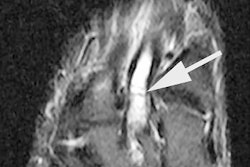The symptoms of a frozen shoulder include the slow onset of pain, localized discomfort near the deltoid insertion, restricted elevation, and restricted external rotation. The condition affects more women than men, and is generally treated with physical therapy, corticosteroid injections, or capsulotomy.
However, the radiological appearance of frozen shoulder is generally normal, and the precise pathogenesis of this condition is unknown, according to Dr. Bernard Mengiardi and colleagues from the University Hospital Balgrist in Zurich.
Mengiardi's group recommended arthrography for assessing cases of suspected frozen shoulder. In their education exhibit presented last week at the RSNA meeting in Chicago, the group suggested that the best MR imaging plane is a T1-weighted sagittal oblique without fat suppression.
"The most often affected structures of the glenohumeral are visible on this sequence: the rotator interval with the coracohumeral ligament, the superior border of the subscapularis tendon, the subscapularis recess, and the long biceps tendon," they wrote.
The quantitative MR criterion for evaluating frozen shoulder includes a thickened coracohumeral ligament. Using this criterion for up to 4-mm thickness, MRI has a specificity of 96% and a sensitivity of 59%, the group reported.
Complete obliteration of the fat triangle between the coracohumeral ligament and the coracoid process is one of the qualitative criteria to look for on MR, they said. Locating this subcoracoid triangle sign yields a specificity of 100% and a sensitivity of 32% for the modality.
Another advantage MR has over other methods for exploring the frozen shoulder -- surgery or arthroscopy -- is that it is noninvasive. This aspect may appeal to patients looking for a solution to their problem sooner rather than later.
"(Frozen shoulder) is believed to be a self-limited condition, however, some patients are unwilling to wait the one to three years often required for resolution of the symptoms," Mengiardi's group said.
MR also has value for assessing frozen shoulder post-treatment. Orthopedic surgeons from Japan found that gadolinium-enhanced MR could clarify whether injections of high-molecular-weight sodium hyaluronate into the glenohumeral joint resulted in clinical improvement (Journal of Orthopaedic Science, 2004, Vol. 9:3, pp. 230-234).
By Shalmali Pal
AuntMinnie.com staff writer
December 10, 2004
Related Reading
Standard and extremity MR bear brunt of shoulder imaging, November 17, 2004
Pitchers' shoulder injury throws a tough diagnosis, August 27, 2004
Shoulders bear brunt of water polo's demands, August 20, 2004
Copyright © 2004 AuntMinnie.com


.fFmgij6Hin.png?auto=compress%2Cformat&fit=crop&h=100&q=70&w=100)





.fFmgij6Hin.png?auto=compress%2Cformat&fit=crop&h=167&q=70&w=250)











